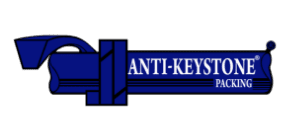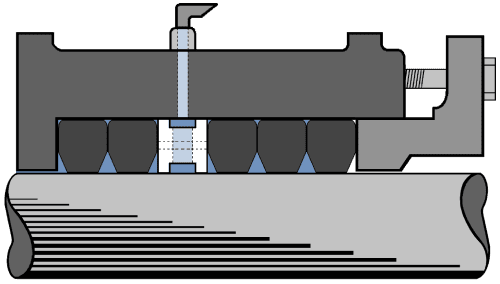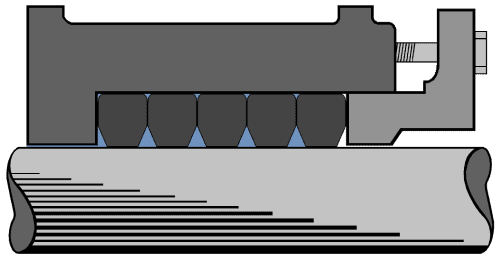Most applications for packing require a flush water system to maintain equal pressure to ensure that no product infiltrates into the stuffing box and on a properly sealed system, no water seeps into the product.
The water reaches the shaft via the holes in a lantern ring which can be made of a variety of materials, such as metal or PTFE. The function of a lantern ring is to allow pressurized water/oil/grease into the stuffing box to help cool the pump shaft or sleeve and to keep contaminants out, greatly extending the life of your equipment and packing. This process is essential to maintain a properly running pumping system.
With graphite & carbon-based packings there is an option in certain applications, within specifications, to operate the equipment in a “flush free” state. This means that there is the possibility of eliminating the flush water system and lantern ring entirely.
The excellent heat transfer properties of these yarns allow the heat generated by the shaft to transfer to the pump housing, taking the place of the flush water for cooling & lubrication. Running “flush free” can eliminate flush waste, reduce fretting corrosion and may be adjusted to run leak free. This can mean fewer gland adjustments, further reducing your operational cost.
Styles 702, 728 & 7800 may be used to attempt “flush free” service. These styles are constructed with graphite & carbon-based yarns, that produce a self-lubricating packing that can extend the shaft or sleeve life of your equipment.
Our Vibradamp® packing can provide the flush-free solution for successful sealing where shaft stability has been a problem. Within its specifications, agitators, blenders and pumps may be reliably operated without seal water.
For abrasive service install a NEBCO™ style 1900 SATB® where applicable or die formed ring of NEBCO™ style 702 AKⅡ® into the bottom of the stuffing box, combine with style 7800 for the ultimate combination set for rotating equipment when flush free service is attempted.
There are several conditions that must be met in order to successfully seal equipment without a flush.
GENERAL GUIDELINES FOR FLUSH FREE SERVICE
To run packing “flush free” you must accomplish three things.
- You must seal “completely” at the entrance to the stuffing box. No product can get into the box between the packing and shaft.
- You must maintain contact between the packing and shaft at all times. This is to keep product from getting in between the shaft and the packing.
- You must have all of the frictional heat generated by the shaft and packing, transfer through the packing and not build up at the shaft/packing contact point.
There are a few things to watch out for if you are trying to seal “Flush Free”:
- Severe abrasives and slurries will “chew” up the packing in a very short time.
- Excessive vibration or cavitation can open up leak paths and blow through the packing.
- Severely worn sleeves can “chew up” the packing and cause premature failure.
- Severely offset shafts will have a natural leak path that can prevent the packing from sealing properly.
- Liquors and light oils can creep under the packing and drip. Once they coat the shaft, it is very difficult to reseal.
- You cannot start with flush and then reduce the water to zero.
- Running “flush free” is not recommended in liquor or acid re-circulating pumps.
To install packing in a “flush free” setup
Follow the standard pump packing installation guidelines, then turn gland follower two extra flats. Start the pump. If leakage occurs tighten until it stops. Steam and smoke will usually occur at the box for a short period of time. Allow packing to “settle in”. Do not back off the gland follower. Do not overtighten the gland nuts as this may damage the packing and/or the shaft.
Disclaimer
*Certain styles & sizes are special order only and may be subject to minimum quantities and/or additional terms & conditions.
**For informational purposes only. New England Braiding Co., Inc. (NEBCO™) believes this information to be the best available. Any specific application you have should not be undertaken without independent study and evaluation for suitability, safety and material compatibility. No warranty is expressed or implied as each application is unique. While we have used the utmost care in the preparation of this information, we assume no liability for errors or responsibility for consequential damages resulting from the use of these products.




